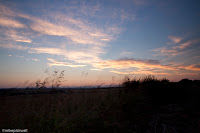Chris Gomersall has worked as a full-time professional wildlife photographer since 1984, initially as staff photographer for the RSPB. He was the first British photographer to win the European Wildlife Photographer of the Year (2007). When I requested this book for my birthday I didn't expect to be writing a review of it for my Landscape Photography module. However, much of the book covers subjects that are pertinent to this course. I feel that there is often an overlap where wildlife finishes and landscape begins, particularly when a plant or creature is depicted in its environment. Many books on wildlife photography, especially with the beginner in mind, cover such topics as choice of camera and lenses, clothing, other equipment and basics of camera technique. Chris does not touch any of these topics in this superb book and chapters range from choosing a subject, using light and space, telling a story and thinking creatively.
In Order From Chaos he quotes John Ruskin when he said 'it is the essence of composition that everything should be in a determined place, perform an intended part, and act, in that part, advantageously for everything that is connected with it'. In this chapter he covers such subjects as the Golden Ratio and the selection process where he discusses the pros and cons of horizontal v. vertical format, whether to crop in close or show more of the habitat and exploring all possible viewpoints. He also considers the choice of background and the placement of the subject in the frame, including the rule of thirds. He goes on to discuss Fractal Geometry and poses the suggestion that much established thinking on photographic composition stems from principles of Euclidean geometry - the idea that simple shapes such as triangles and circles can be exploited to make agreeable pictures.
In his chapter on Seeing the Light, Chris talks about tonal and range and exposure and looks at the theory and practicality of 'exposing to the right' in order to retain as much information as possible in the shadows, whilst being careful to avoid clipping the highlights .He looks at light source and direction, discussing the advantages and disadvantages of using frontal and side lighting and working into the light to achieve pleasing rim lighting effects. He looks at the quality of light and the benefits of shooting during the magic hours around sunrise and sunset and then moves on to discuss the colour temperature of light. Complementary and harmonious colours are discussed as well as working in monochrome and black and white.
In the chapter on Seizing the Moment Chris quotes Henri Cartier-Bresson when he says ' The creative act lasts but a brief moment, a lightning instant of give-and-take, just long enough for you to level the camera and to trap the fleeting prey in your little box'. He considers capturing that 'Decisive Moment' and suggests that it is vital to success in wildlife photography. He goes on to write that 'To preserve the very essence, spirit or 'jizz' of your subject in a fraction of a second is no mean feat - so much more demanding than recording a moving sequence, but so much more eloquent when done well; successfully selecting and plucking out that infinitesimal slice of time, a miniscule extract from the history of the universe that seeks to convey some eternal truth. It gets to the very essence and magic of what we do'. He goes on to investigate how shutter speed can help in catching this moment and looks at the history of stopping movement by such exponents as Eadweard Muybridge and later, Jaque-Henri Lartigue. Slower shutter speeds are also considered and how, through their judicious use, a sense of motion can be conferred to the image.
In the chapter on Finding Your Voice he touches on developing your own style, a topic also covered in this course. He suggests many options to experiment with and warns of the lack of creativity involved in copying someone else's images or planting your tripod in the marks of someone else.
A chapter follows on using your images to tell a story and different ways of presenting them such as single mounted prints in exhibitions or the walls of your home, themed portfolios, multi media presentation and using them for public talks, both of which I do with my own work. He also discusses the use of wildlife photography in aiding conservation work. I try to get this message over when I use my photographs in schools when I talk to children, often using slogans such as Extinction is for Ever and This is Your World, Do Not Spend It All At Once.
I have recently entered some macro shots into the International Garden Photography of the Year competition and added them to my blog in the Other Photography section (see menu). In the blog I have detailed how this book has inspired my own work.
Chris's book is lavishly illustrated with his own stunning work and he finishes with some case studies where he explains how he took some of his most published work.
This far from being 'just an instruction manual' and is full of links to other genres and past masters of the craft of photography. It is truly inspirational.













































